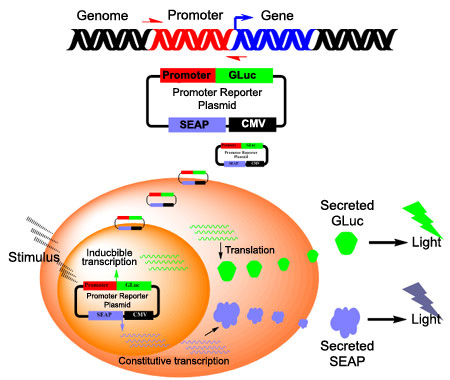Cell-based assays have become a classic way to monitor cells’ reactions to a treatment or a specific stimulus. They involve a reporter construction and a detection system. The classic system is Firefly Luciferase, combined or not with Renilla Luciferase. Luciferases allow simple data acquisition on a plate reader.
Nevertheless, Firefly Luciferase requires cell lysis. End-point acquisition is the only method and optimizations of the right moment is recommended. To bring more convenience, robustness and higher sensitivity, Gaussian luciferase can well be your better choice.
Discover the Dual and secreted Gaussian Luciferase detection kit

A more convenient system is Gaussian Luciferase, because it is secreted by the cells and no cell lysis is required any more.
This makes new applications possible:
- Live cell assays
- Real-time study
It’s compatible with High-throughput assays and end-point studies.
Combined with the secreted alkaline phosphatase (SEAP) as reference expression, Gaussian Luciferase (GLuc) provides a new generation dual and secreted detection system of the reporter constructs.
The benefits are numerous:
-

More stable activity of the modified GLuc, in blue, vs the wild type, in red. High sensitivity – GLuc is 1000-fold more sensitive than firefly or Renilla luciferase
- High reproducibility – Normalized data from the ratio GLuc/SEAP, enabling transfection-normalization for accurate across-sample comparison
- Optimal end-point acquisition – Simple optimisation of the right moment working on the supernatants
- Savings on material – without cell lysis, the number of points can be reduced
There have been over 80 publications in 2016 and 2017, and this is just the beginning!
The detection system is provided as a affordable and convenient kit.
This GLuc is a modified version (in blue) of the wild type (in red) in order to get more stable activity.
Pathway activation monitored with promoter reporters
The corresponding reporter constructions are promoter reporters to monitor the gene of interest activation.

As illustrated above, the promoter of interest codes for GLuc so that the detection of the luciferase activity in the culture supernatant reveals and quantifies the level of activation of the gene of interest. With selection of a key effector gene, it monitors a specific pathway activity. It can be used to test and optimise cellular response to a treatment.
3’UTR miRNA target validation with miTarget reporters
GLuc can also be used to monitor and quantify the inhibition function of an miRNA onto its target (UTR sequence of a targeted gene).

Analysis can be sophisticated, as shown below.

The transfected cells with the miTarget Lin28 reveal the expression of the GLuc (in orange) for which the mRNA has the 3’UTR of the Lin28 gene. The over-expression of the miRNA miR-125a reduces the GLuc activity and so confirms that the Lin28 3’UTR is a target of miR-125a (pale orange bar). Then the addition of a miR-125a inhibitor rescues the GLuc expression and so confirms the specificity of the Lin28 regulation by miR-125a. You’ll notice that the last blue bar is higher than the initial orange bar. It shows that before the miR-125a over-expression, there is a miR-125a endogenous expression into the cells that reduces partially the GLuc activity.
Cell line engineering to establish a cell based assay
Transient transfection is possible thanks to the SEAP. Indeed, the constitutive expression of the SEAP depends only on the transfection efficiency. So the ratio GLuc/SEAP provide accurate across-sample comparison. I would recommend the PolyJet transfection reagent because it’s inexpensive and has high efficiency over 80+ cell types. Nevertheless, feel free to contact me for more specific solutions, I’ll be pleased to help.
Alternatively, ready-to-use cell lines exist such as the NFAT-GLuc, the PKC-GLuc, TCF/LEF-GLuc. Last but definitely not least, tebu-bio’s own European based labs can develop dedicated cell lines for your cell based assays. Just contact me if you’re keen to find out more!



